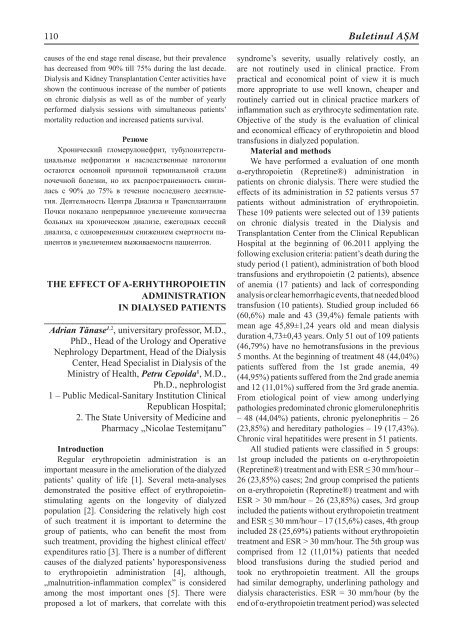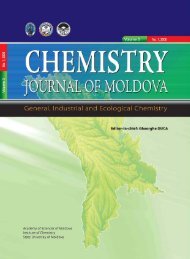stiinte med 3 2011.indd - Academia de ÅtiinÅ£e a Moldovei
stiinte med 3 2011.indd - Academia de ÅtiinÅ£e a Moldovei
stiinte med 3 2011.indd - Academia de ÅtiinÅ£e a Moldovei
Create successful ePaper yourself
Turn your PDF publications into a flip-book with our unique Google optimized e-Paper software.
110<br />
causes of the end stage renal disease, but their prevalence<br />
has <strong>de</strong>creased from 90% till 75% during the last <strong>de</strong>ca<strong>de</strong>.<br />
Dialysis and Kidney Transplantation Center activities have<br />
shown the continuous increase of the number of patients<br />
on chronic dialysis as well as of the number of yearly<br />
perfor<strong>med</strong> dialysis sessions with simultaneous patients’<br />
mortality reduction and increased patients survival.<br />
Резюме<br />
Хронический гломерулонефрит, тубулоинтерстициальные<br />
нефропатии и наследственные патологии<br />
остаются основной причиной терминальной стадии<br />
почечной болезни, но их распространенность снизилась<br />
с 90% до 75% в течение последнего десятилетия.<br />
Деятельность Центра Диализа и Трансплантации<br />
Почки показало непрерывное увеличение количества<br />
больных на хроническом диализе, ежегодных сессий<br />
диализа, с одновременным снижением смертности пациентов<br />
и увеличением выживаемости пациентов.<br />
THE EFFECT OF Α-ERHYTHROPOIETIN<br />
ADMINISTRATION<br />
IN DIALYSED PATIENTS<br />
_______________________________________<br />
Adrian Tănase 1,2 , universitary professor, M.D.,<br />
PhD., Head of the Urology and Operative<br />
Nephrology Department, Head of the Dialysis<br />
Center, Head Specialist in Dialysis of the<br />
Ministry of Health, Petru Cepoida 1 , M.D.,<br />
Ph.D., nephrologist<br />
1 – Public Medical-Sanitary Institution Clinical<br />
Republican Hospital;<br />
2. The State University of Medicine and<br />
Pharmacy „Nicolae Testemiţanu”<br />
Introduction<br />
Regular erythropoietin administration is an<br />
important measure in the amelioration of the dialyzed<br />
patients’ quality of life [1]. Several meta-analyses<br />
<strong>de</strong>monstrated the positive effect of erythropoietinstimulating<br />
agents on the longevity of dialyzed<br />
population [2]. Consi<strong>de</strong>ring the relatively high cost<br />
of such treatment it is important to <strong>de</strong>termine the<br />
group of patients, who can benefit the most from<br />
such treatment, providing the highest clinical effect/<br />
expenditures ratio [3]. There is a number of different<br />
causes of the dialyzed patients’ hyporesponsiveness<br />
to erythropoietin administration [4], although,<br />
„malnutrition-inflammation complex” is consi<strong>de</strong>red<br />
among the most important ones [5]. There were<br />
proposed a lot of markers, that correlate with this<br />
Buletinul AŞM<br />
syndrome’s severity, usually relatively costly, an<br />
are not routinely used in clinical practice. From<br />
practical and economical point of view it is much<br />
more appropriate to use well known, cheaper and<br />
routinely carried out in clinical practice markers of<br />
inflammation such as erythrocyte sedimentation rate.<br />
Objective of the study is the evaluation of clinical<br />
and economical efficacy of erythropoietin and blood<br />
transfusions in dialyzed population.<br />
Material and methods<br />
We have perfor<strong>med</strong> a evaluation of one month<br />
α-erythropoietin (Repretine®) administration in<br />
patients on chronic dialysis. There were studied the<br />
effects of its administration in 52 patients versus 57<br />
patients without administration of erythropoietin.<br />
These 109 patients were selected out of 139 patients<br />
on chronic dialysis treated in the Dialysis and<br />
Transplantation Center from the Clinical Republican<br />
Hospital at the beginning of 06.2011 applying the<br />
following exclusion criteria: patient’s <strong>de</strong>ath during the<br />
study period (1 patient), administration of both blood<br />
transfusions and erythropoietin (2 patients), absence<br />
of anemia (17 patients) and lack of corresponding<br />
analysis or clear hemorrhagic events, that nee<strong>de</strong>d blood<br />
transfusion (10 patients). Studied group inclu<strong>de</strong>d 66<br />
(60,6%) male and 43 (39,4%) female patients with<br />
mean age 45,89±1,24 years old and mean dialysis<br />
duration 4,73±0,43 years. Only 51 out of 109 patients<br />
(46,79%) have no hemotransfusions in the previous<br />
5 months. At the beginning of treatment 48 (44,04%)<br />
patients suffered from the 1st gra<strong>de</strong> anemia, 49<br />
(44,95%) patients suffered from the 2nd gra<strong>de</strong> anemia<br />
and 12 (11,01%) suffered from the 3rd gra<strong>de</strong> anemia.<br />
From etiological point of view among un<strong>de</strong>rlying<br />
pathologies predominated chronic glomerulonephritis<br />
– 48 (44,04%) patients, chronic pyelonephritis – 26<br />
(23,85%) and hereditary pathologies – 19 (17,43%).<br />
Chronic viral hepatiti<strong>de</strong>s were present in 51 patients.<br />
All studied patients were classified in 5 groups:<br />
1st group inclu<strong>de</strong>d the patients on α-erythropoietin<br />
(Repretine®) treatment and with ESR ≤ 30 mm/hour –<br />
26 (23,85%) cases; 2nd group comprised the patients<br />
on α-erythropoietin (Repretine®) treatment and with<br />
ESR > 30 mm/hour – 26 (23,85%) cases, 3rd group<br />
inclu<strong>de</strong>d the patients without erythropoietin treatment<br />
and ESR ≤ 30 mm/hour – 17 (15,6%) cases, 4th group<br />
inclu<strong>de</strong>d 28 (25,69%) patients without erythropoietin<br />
treatment and ESR > 30 mm/hour. The 5th group was<br />
comprised from 12 (11,01%) patients that nee<strong>de</strong>d<br />
blood transfusions during the studied period and<br />
took no erythropoietin treatment. All the groups<br />
had similar <strong>de</strong>mography, un<strong>de</strong>rlining pathology and<br />
dialysis characteristics. ESR = 30 mm/hour (by the<br />
end of α-erythropoietin treatment period) was selected

















